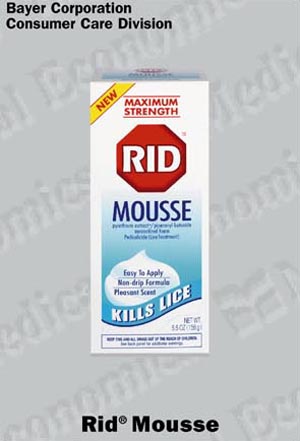Active Ingredients
(calculated without propellant)
Piperonyl butoxide (4%)
Pyrethrum extract * (equivalent to 0.33% pyrethrins)
*50% extract (not USP)
Inactive Ingredients:
cetearyl alcohol, isobutane, PEG-20 stearate, propane, propylene glycol, purified water, quaternium-52, SD Alcohol 3-C (26.5% w/w)
Uses:
treats head, public (crab), and body lice
Warnings:
Do not use
near the eyes
Ask a doctor before use if you have
an allergy to ragweed
When using this product:
Stop use and ask a doctor if:
Keep out of reach of children.
If swallowed, get medical help or contact a Poison Control Center right away.
Directions:
-
Important: Read warnings before using:
-
shake well before using
-
holding the can upside down, apply RID® Mousse to
dry hair
or other affected area. Massage until all the hair is thoroughly wet with product. For best results against head lice, see complete Directions in the Consumer Information Insert.
-
allow product to remain on the hair for 10 minutes but no longer
-
wash area thoroughly with warm water and soap or shampoo
-
a fine-toothed comb or a special lice/nit removing comb may be used to help remove dead lice or their eggs (nits) from hair
-
a second treatment must be done in 7 to 10 days to kill any newly hatched lice
Other Information:
-
store at 20°-25°C (68°-77°F)
-
do not store at temperature above 43°C (110°F)
-
keep in a cool place out of the sun
Questions?
call
1-800-RID LICE
(1-800-743-5423)
Distributed By
Bayer Corporation
Consumer Care Division
Morristown, N.J. 07960 USA
PRODUCT PHOTO(S):
NOTE: These photos can be used only for identification by shape, color, and imprint. They do not depict actual
or relative
size.
The product samples shown here have been supplied by the manufacturer and reproduced in full color by PDR as a quick-reference identification aid. While every effort has been made to assure accurate reproduction, please remember that any visual identification should be considered preliminary. In cases of poisoning or suspected overdosage, the drug' identity should be verified by chemical analysis.
Copyright© 2001 Medical Economics

